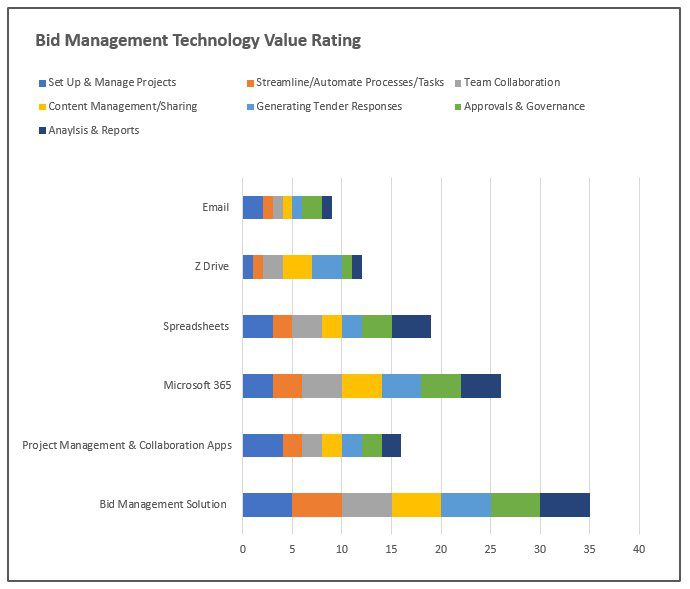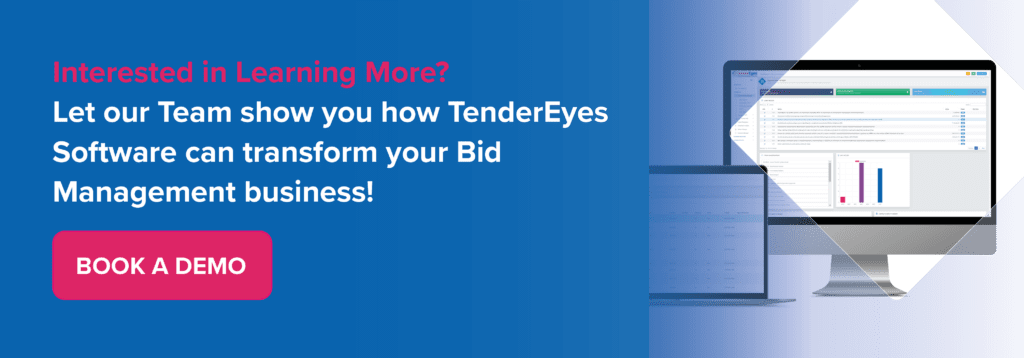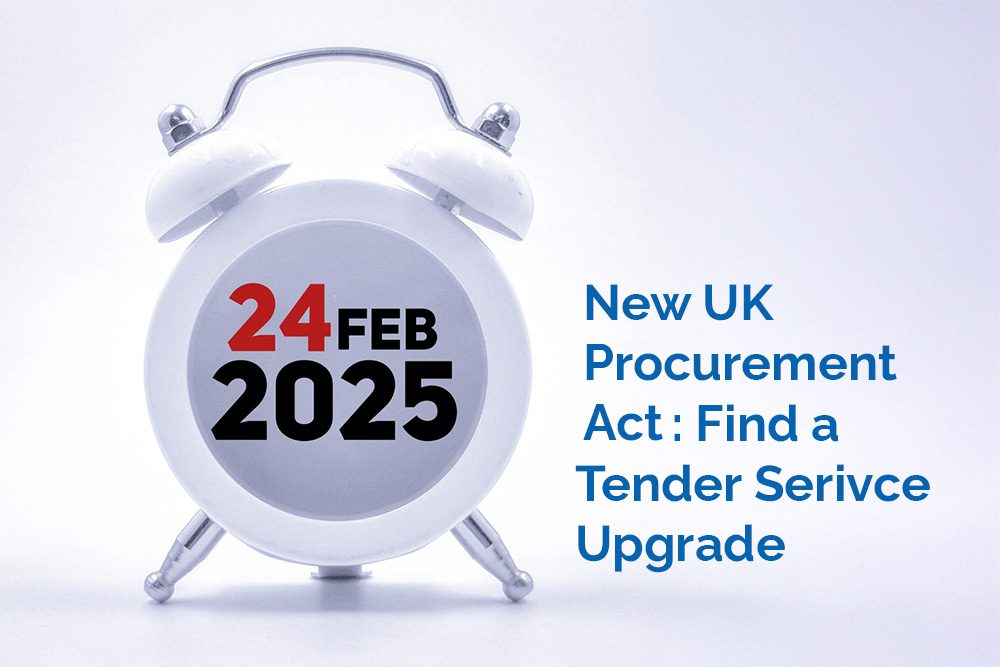We all know having the right tools for the job is essential!
So why are so many Bid Teams still struggling with generic business tools to manage their highly complex and pressurised tendering activities?
In this article we explore the risks associated with relying on these tools and the impact this approach has on the quality of tender responses and win rates. Plus, we examine the benefits of investing in a dedicated Bid Management solution.
Bid Management Status Quo
As we have discussed in a previous article ‘The Tender Process: What to Expect, Step by Step’, tendering is a systematic process defined for both Procuring Agencies and Bidding Organisations.
Much of the work between the two parties is now streamlined and digitally undertaken on-line through Public Procurement Portals (such as TED EU and FTS UK) and Procuring Agency Tender Portals.
However, Bidding Organisations often still rely on generic business tools to manage their internal tender processes and activities, such as:
- ‘Z’ Drives
- Spreadsheets
- Microsoft 365
- Project Management & Collaboration Apps
While offering some level of support, these solutions can result in disconnected and inefficient bid management working practices. These added challenges can lead to the submission of poor-quality tender responses and inconsistent win rates.
In turn, this will impact team morale and may cause employee and skills attrition, further compounding the problems.
So, let’s review the most commonly used business technologies and how they impact the work required to manage the complex coordination of people, tasks and content required to submit tenders.
We have assessed each technology against 7 key criteria for delivering best practice bid management. Each with a possible technology value rating of 5 points, with 1 being of low value and 5 being of high value. The Chart below provides a summary of all technologies and associated scores.
We have also indicated the level of expertise required to optimise the use of the technologies for Bid Management activity. 1 being of low level of expertise and 5 being of high level of expertise.

Email for Tender Management
Established in business since the 1980s, email has been the most used tool for business communications.
Queen Elizabeth II was the first head-of-state to use email. She tried out ARPANET’s electronic mail program during a visit in 1979 to the Royal Signals and Radar Establishment in England. They gave her the username HME2 for “Her Majesty Elizabeth II.” Wikipedia.
While email provides a good communication platform with some abilities to assign and prioritise tasks and collaborate with others, it is very limited in its functionality and collaboration capabilities.
Challenges include:
- Intensive manual and repeated activity set up
- Danger of missed or ignored emails and requests
- Creates individual information silos
- Lack of visibility to people and resources
- Lack of flexibility and process functionality
- Emailing documents perpetuates the creation of multiple versions of offline docs that need to be combined at a later stage and may even be lost or confused.
If really pressed, you could undertake a very simple one-off tender through this platform but managing multiple complex tenders with involvement of multiple stakeholders would be near on impossible.
Technology Value Rating: 9/35
Level of Expertise: 1/5
‘Z’ Folders for Tender Management
The submission of tenders involves the management of huge amounts of information. This includes the Procuring Agency’s evaluation criteria, scoring mechanisms and supplier questionnaires through to the bidding organisation’s scoring analysis, key business information and content for tender responses.
At the very minimum a Bid Team will set up a ‘Z’ folder to store all relevant documentation and content. This may be held on individual’s hard drive or a central repository but is still limited in delivering good content management practices.
Challenges include:
- Inconsistent directory structures and naming conventions
- Limited or no access for wider collaborators
- Dependent on manual versioning and control
- Limited search functionality
- No mechanism for approvals and sign offs
- No audit capabilities.
Technology Value Rating: 12/35
Level of Expertise: 1/5
Spreadsheets for Tender Management
Spreadsheets were originally developed in 1969 as computerised analogues of paper accounting worksheets. Since then, they have become a go-to tool for many business analysis application such as sales forecasting, marketing ROI, delivery and support service tracking etc.
They have also been commandeered and customised for project management work.
However, the complexity of tasks and stakeholders involved in multiple tender projects cannot be successfully managed within this platform and can cause innumerable problems.
Challenges include:
- Time and expertise to set up formulas, pivot tables and macros
- Hard to manage for multiple users
- Requires intensive manual input of data
- Prone to multiple versioning by multiple people
- Hard to keep up-to-date and correct information
- Fear and frustration for non-expert users
- No capability to comment or audit trail
- Viewing and interpreting information difficult
- Maintenance and fragility problems.
Spreadsheets do have a place in Bid Management, but for the use they were intended namely data and number analysis. They play a vital role in the assessment and testing of tender responses against Tender Evaluation Criteria and Scoring Mechanisms as well as in the use of pricing models and specifications.
Technology Value Rating: 19/35
Level of Expertise: 3/5

Microsoft 365 for Tender Management
Many bid teams will have expanded into using additional Microsoft Office applications such as Word, One Drive, Teams, Project etc. to help manage their tenders. While these tools offer a greater level of support in coordinating workload, they are still fundamentally business tools with generic functionality.
Addressing the intricacies and complexities of bid management practices would require time and high levels of expertise to design, set up and use these solutions effectively.
Challenges include:
- Multiple applications to learn and understand
- Requires level of expertise to optimise use
- Signing in and compatibility issues
- Easily become unwieldy without defined user guidelines
- Limited risk management and performance visibility and control.
Technology Value Rating: 26/35
Level of Expertise: 4/5
Collaboration and Project Management Tools for Tender Management
With the advent of cloud-based solutions there are now a plethora of business collaboration and project management tools such as Slack, Asana, Monday, Trello and Google Docs etc.
While these tools are easily accessible and intuitive to use, they are not ideal for complex scenarios, requiring time and work to set up and develop workarounds where functionality is unavailable.
- Functionality constrained to generic business needs
- Hard to match to structure and complex workflows
- Lack of governance and risk management
- Hard to integrate with other technology used in managing and creating bids.
Technology Value Rating: 16/35
Level of Expertise: 3/5

Time for Change
Inevitably Bid Teams become frustrated with using generic business tools to manage their tender submissions. The need for repetitive manual activities and workarounds causes unnecessary delays and mistakes.
These disjointed and customised solutions may become increasing fragile and even break at crucial times of the bidding process, increasing risks to the business.
The need to review and consider other options is often triggered by increased workloads, poor performance, substantial tender losses, low morale and employee attrition.
This scenario is no different than experienced in many other business disciplines. For example, a Finance Team may start out using spreadsheets, email and Word for their financial and accounting activities, until inefficiencies cause problems. The business will then invest in dedicated accounting software such as Sage or Zero etc. to deliver a more integrated, streamlined, efficient solution. And often wonder why they didn’t do it sooner!
So, what are the options for Bid Management Teams?
Build or Buy?
One solution, a bidding organisation may consider is to develop an in-house solution or commission a third-party provider such as Salesforce, SAP, Oracle etc. to adapt their solution to meet these new needs.
However, this is a big risk and a big investment in both time and money. Firstly, in accurately accounting for and specifying all needs, functionality and workflows for end-to-end bid management. Secondly project managing the build, testing and implementation of the solution. Thirdly in investing in training, support, further solution maintenance and development. This can run into £100Ks.
Adopting a Dedicated Bid Management Solution
A more cost effective and reduced risk option is to buy a dedicated bid management system from a proven and trustworthy vendor such as TenderEyes.
TenderEyes software has been specifically designed to manage the whole end-to-end bid management process, from initial opportunity pursuit through to bid submission and contracts delivery.
The solution delivers powerful tools to streamline and automate activities, better manage content and deliver deeper collaboration with all stakeholders. The solution provides in-built best practice, governance and approvals as well as visibility and analysis of tender projects progress and results.
Benefits include:
- Quick deployment with flexible scalable anywhere, anytime access
- Customised for own bid strategies, delivery models and outcomes
- Easy to use with intuitive learning and navigation
- Dedicated training and support.
Technology Value Rating: 35/35
Level of Expertise: 3/5








